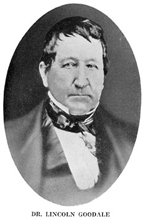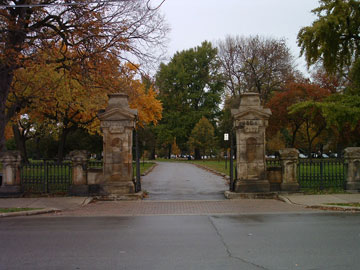
Columbus, Ohio USA
Return to Homepage www.shortnorth.com
The Short North That Was
Dr. Lincoln Goodale and His Living Legacy
Part Five
April 2007 Issue
by Beverly Mullet Randall
email bmullet@netwalk.com
Goodale Park: The 1870s Improvements and a Menagerie
Dr. Lincoln Goodale, Courtesy of the Columbus Metropolitan Library, Division of Biography, History & Travel After Goodale Park was reverted from a Civil War camp to a park in 1861, there seems to have been little news regarding the park for the remaining decade, other than the passing of Dr. Lincoln Goodale, donator of the park land, in 1868. As designated by the original park deed, Dr. Goodale had served as one of the four park oversight committee members. After his passing, the park was managed by a three-person committee of city council.
Improvements Make Goodale Park a Popular Place
The 1870s brought many improvements to Goodale Park. In 1870, the massive stone pillars and iron gate were constructed at the south entrance. A tall fountain with a 25-foot wide basin was added near the southwest corner in 1872, and a stone trough for the overflowing water was added to the west carriage way “to allow ambling equines an opportunity for quenching their thirst.”
That same year, construction of East Lake began in the northeast corner near Park Street. A boat house was built and gas pipes were extended to it. Lack of funds prevented completion of the lake until three years later. Efforts began in 1874 to identify and hire a sculptor to create a Lincoln Goodale monument and a local newspaper led a plea to hire a professional landscape gardener to efficiently plan the layout for the grounds.
Goodale Park was becoming a very popular place. During the summers, croquet parties were frequently held on the expansive grassy knolls in the park. One day in August 1873, 346 carriages entered the gate. The park was described as a popular resort on account of its excellent management and as a delightful place “admirably adapted for ladies and children to visit during the day for a prolonged visit.”
On one summer Sunday in 1874, three to four thousand people gathered in the park for an outdoor religious meeting. When the people started to sing, the park keeper approached one of the group leaders and told him they were not permitted to hold their meeting there. The group leader asked if the meeting could continue since it had already started and that he would take responsibility for any damage that might occur or any trouble that might arise between the keeper and the park committee. The keeper said if they continued it would be with his protest. Mayor Bull was consulted after the meeting had taken place and said he had no complaint with the movement.
Water was let into the first Goodale Lake in 1875 and small boats were allowed on the water, adding considerably to the park’s beauty. Ice skating was a possibility for winter. However, as soon as the lake was completed there were immediately safety concerns and suggestions for improvement. The lake was 6 feet at its deepest point, raising concerns about the dangers of children drowning and suggestions that it be filled in so that the entire lake was a uniform depth of three to four feet.
The stone gate at the south entrance of Goodale Park was created for the city of Columbus in 1870. According to Terry Sherburn, local historian, this gate is the only city-contracted artistic structure from 1870 or earlier that still exists in Columbus. ©Photo/Beverly Mullet Randall The Menagerie
The Goodale Park menagerie seemed to start small – in May 1874 there appears to have been only a bear and a lone wolf to keep it company. A month later in June that year, the bear died in spite of efforts to save it. The cause of death was thought to be a lingering lung disease brought on by exposure to inclement weather.
By 1877, the menagerie had grown to two bears, male and female; two wolves, male and female; 19 rabbits of all colors; and three foxes. The bears were three years old and had been presented to the city as cubs. They were now described as full-grown, magnificent specimens worth seeing. The bear couple were expected to produce more cubs during the winter.
In November 1877, the animals were moved from their old quarters located near the park family residence to a larger, new building located on Buttles Avenue near the north end of the lake. The building had iron bars on the front and faced toward the park drive so the visitors could view the animals more easily. There were no openings on the back of the enclosure that faced Buttles. The new quarters were designed so that women and children could see the animals without leaving their carriage.
Moving Fannie, the female bear, proved to be a dangerous task. The keeper, Patrick Cain, had cared for the bears since they were introduced into the park as cubs and he was the only person who could enter the dens. Cain entered the female bear’s den and coaxed her into the moving crate. Once she was in the crate, she frantically tried to escape, tearing the nails off her left fore foot and making kindling wood out of the slates of the crate door. Four or five men, including the keeper, rode on top of the crate to keep her from escaping as they hurriedly drove to the new den and placed the sliding door of the moving crate next to the door of the den so that she could pass through. When they removed the sliding door of the crate she ran into the den where she spent the next 30 minutes pacing excitedly. Cain fed her bread and corn and talked “bear talk” to pacify her until she became very affectionate and accepted her new surroundings.
Councilman Cochran, one of the Goodale Park committee members, was there watching but declined jumping on top of the crate to keep Fannie from escaping while she was being moved. The reporter also declined. A crowd began to gather and seemed to be enjoying the scene. The consensus was that Fannie probably wouldn’t have hurt Cain but that she seemed very intent on hurting one or two of the “sons of Erin” assisting him.
The male bear, Jack, was much easier to move, being very gentle and good-natured. After Cain led him into his new den, he and Fannie had a “bear conversation” through a small barred hole in the door that separated their dens and then settled down and seemed content.
When the wolves were moved, one grabbed Cain on the calf of his leg when he wasn’t looking and he screamed. He soon realized it wasn’t a bad bite, much to the amusement of the crowd that had gathered. The wolves were named Danger and Fair Maid.
All the animals in the 1877 menagerie had been donated at different times by various individuals and, at the time, all were said to be in very good condition. The 19 rabbits were all offspring of brace brought from City Park. The city apparently had plans to expand the menagerie gradually by acquiring a few additional young animals each year and breeding them until the park could “boast of having a first class collection.” It’s unclear what became of this small menagerie of animals, but by 1886 they were gone from the Park due to lack of interest.
Special thanks to the Columbus Metropolitan Library, Division of Biography, History and Travel for their help.©2007 Short North Gazette, Columbus, Ohio. All rights reserved.

